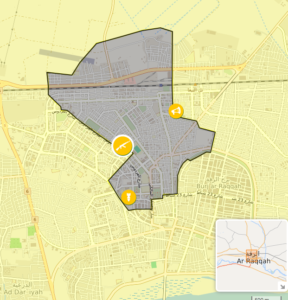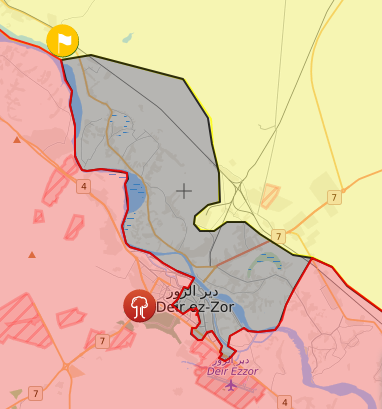Certain factions of the Washington establishment (here’s a good example) are demanding that Obama “do something” to stop the fighting around Aleppo in Syria, the “something” in this case being the threat of force, or even actual use thereof, to stop Russian airstrikes and prevent a “humanitarian disaster.” And Hillary Clinton is calling for a no-fly zone.
To which I reply: Why?
We can’t back the good guys in the Syrian civil war because there are no good guys. Assad’s ruling faction are scumbags. The Russians backing Assad are scumbags. Hezbollah, fighting on Assad’s side, are scumbags. The Iranian mullahs backing Assad are scumbags. Turkey is currently ruled by Erdogan’s Islamist scumbags, and Turkey is more interested in attacking the Kurds than the Islamic State. The Free Syrian Army is riddled with Islamist scumbags. The al-Nusra front are scumbags. The Islamic State is made up of the very worst scumbags in the region (and world). The only notable faction that aren’t scumbags are the Kurds, who, as an ethnic and geographic minority, are in no position to rule Syria, or even a significant fraction of it.
To the extent that Obama’s imaginary red lines and desultory, ineffectual backing of Syrian rebel groups have harmed America’s reputation for competence in the region, the damage has already been done. (Indeed, the Obama/Clinton/Kerry strategy for fomenting regime change in the hope that things would turn out better, like a liberal funhouse mirror distorted reflection of George W. Bush’s far more limited regime change goals in Iraq, have made things worse across the region.) We have no pressing national interest at stake in the Syrian civil war, there’s not a contending faction (outside the peripherally-involved Kurds) worth backing, and it’s not apparent what such an intervention might reasonably achieve.
All of which makes me incredulous when I read pieces that suggest that Obama is considering military actions in Syria.
Even some on the right have been agitating for the United States to “do something” in Syria, and S. E. Cupp’s Twitter timeline has gone to an “all heart-tugging photos of Syrian children” format without saying why it is the United State’s interest to intervene in Syria or proposing anything concrete as to what form that intervention should take.
A large part of the current push to intervene in Syria seems to be coming from an interest group called The Syria Campaign. Who is behind it?
From that Zero Hedge piece:
A careful look at the origins and operation of The Syria Campaign raises doubts about the outfit’s image as an authentic voice for Syrian civilians, and should invite serious questions about the agenda of its partner organizations as well.
A creation of international PR firms
Best known for its work on liberal social issues with well-funded progressive clients like the ACLU and the police reform group, Campaign Zero, the New York- and London-based public relations firm Purpose promises to deliver creatively executed campaigns that produce either a “behavior change,” “perception change,” “policy change” or “infrastructure change.” As the Syrian conflict entered its third year, this company was ready to effect a regime change.
On Feb. 3, 2014, Anna Nolan, the senior strategist at Purpose, posted a job listing. According to Nolan’s listing, her firm was seeking “two interns to join the team at Purpose to help launch a new movement for Syria.”
At around the same time, another Purpose staffer named Ali Weiner posted a job listing seeking a paid intern for the PR firm’s new Syrian Voices project. “Together with Syrians in the diaspora and NGO partners,” Weiner wrote, “Purpose is building a movement that will amplify the voices of moderate, non-violent Syrians and mobilize people in the Middle East and around the world to call for specific changes in the political and humanitarian situation in the region.” She explained that the staffer would report “to a Strategist based primarily in London, but will work closely with the Purpose teams in both London and New York.”
On June 16, 2014, Purpose founder Jeremy Heimans drafted articles of association for The Syria Campaign’s parent company. Called the Voices Project, Heimans registered the company at 3 Bull Lane, St. Ives Cambridgeshire, England. It was one of 91 private limited companies listed at the address. Sadri would not explain why The Syria Campaign had chosen this location or why it was registered as a private company.
Along with Heimans, Purpose Europe director Tim Dixon was appointed to The Syria Campaign’s board of directors. So was John Jackson, a Purpose strategist who previously co-directed the Burma Campaign U.K. that lobbied the EU for sanctions against that country’s ruling regime. (Jackson claimed credit for The Syria Campaign’s successful push to remove Syrian president Bashar Al-Assad’s re-election campaign ads from Facebook.) Anna Nolan became The Syria Campaign’s project director, even as she remained listed as the strategy director at Purpose.
From The Syria Campaign’s own website:
The Syria Campaign is a non-profit organisation registered as a company in the United Kingdom as The Voices Project—company number 8825761. (You can’t be a registered charity in the UK if most of your work is campaigning.)
We have a Governing Board who are legally responsible for the organisation and oversee strategy and finance for The Syria Campaign. The board members are Daniel Gorman, Ben Stewart, Sawsan Asfari, Tim Dixon and Lina de Sergie.
Jeremy Heimans co-founded “a campaign group in the U.S. presidential elections that used crowd-funding to help a group of women whose loved ones were in Iraq hire a private jet to follow Vice-President Dick Cheney on his campaign stops, in what became known as the “‘Chasing Cheney’ tour” among other leftist activism.
Daniel Gorman heads “the UK’s largest festival of contemporary Arab culture.”
Ben Stewart is a Greenpeace activist who has a grudge against Russia for detaining 30 of his fellow travelers.
Sawsan Asfari is “active in various charities that help Palestinians across the Arab world” and is the wife of Syrian-born British billionaire Ayman Asfari.
Lina de Sergie seems to more commonly go by Lina Sergie Attar. “She is a Syrian-American architect and writer from Aleppo. She co-developed Karam’s Innovative Education initiatives: the creative therapy and holistic wellness program for displaced Syrian children and the Karam Leadership Program, an entrepreneurship and technology program for displaced Syrian youth.” Yes, I’m sure “holistic wellness” is a big priority for Syrian refugees. Karam’s Mission Statement: “We develop Innovative Education programs for Syrian refugee youth, distribute Smart Aid to Syrian families, and fund Sustainable Development projects initiated by Syrians for Syrians.”
Tim Dixon has quite an extensive resume, being a former speechwriter to two Australian Labor Party Prime Ministers and involved in a large number of causes:
– a large-scale initiative to help change hearts and minds on the global refugee crisis;
– The Syria Campaign, to move the world to action on the humanitarian crisis in Syria;
– Everytown, the movement to tackle gun violence in America
Etc.
So, to summarize: It’s run by international left-wing activists in favor of Europe accepting more “Syrian” “refugees”, soft jihadis, and gun banners.
These are not the sort of people I want driving American national security decisions.
The situation in Syria is horrible, but outside territory held by the Islamic State, it’s the same type of horrible that has plagued the Middle East pretty much constantly absent control by a ruling power with sufficient force to keep the endemic ethnic strife under wraps. Wars there are fought under Hama rules, not those of the Geneva Convention.
It is not in the best interests of the United States to intervene militarily in Syria. We have no compelling national security interest in Syria right now, there’s no faction worth backing, and trying to “create safe areas” or “establish no-fly zones” would be dangerous, cost-prohibitive and unlikely to succeed.
Sometimes the best choice is doing nothing at all.

